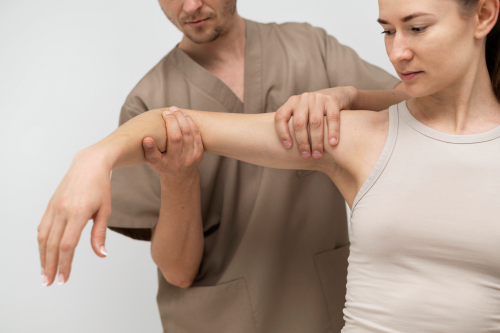"Side-to-Side Hops"
1.
Prologue to Side-to-Side Bounces Side-to-side jumps, frequently named horizontal bounces or skaters, are a type of plyometric practice that spotlights on parallel development. This development includes bouncing side-to-side from one foot to the next, underlining power, nimbleness, equilibrium, and coordination. Dissimilar to vertical or straight developments, horizontal activities like side-to-side jumps challenge the body to move in an alternate plane, focusing on muscles less much of the time enacted during conventional forward or in reverse developments.
2.
The Mechanics of Side-to-Side Jumps The side-to-side bounce practice is performed by pushing off one leg and arriving on the contrary leg while keeping a low, controlled position.
The arms assume a strong part, giving equilibrium and helping drive.
Legitimate strategy includes:
Beginning Position:
Remaining with feet hip-width separated, knees somewhat bowed, and arms along the edges or in front for balance.
Execution:
Driving over the ground with one leg, impelling the body horizontally while drawing in the center and leg muscles. Landing delicately on the contrary leg with a slight curve in the knee retains influence and forestalls injury.
Redundancy:
Proceeding with the development to and fro, keeping up with cadence and strength.
3.
Solid Initiation and Advantages Side-to-side jumps are principally a lower-body practice yet require commitment from the whole body.
Key muscles enacted include:
Quadriceps and Hamstrings:
Fundamental for knee expansion and flexion, balancing out the leg during the leap and landing stages.
Gluteus Maximus and Medius: Work to drive parallel developments and keep up with hip solidness.
Calves (Gastrocnemius and Soleus):
Help in the impetus off the ground and control during landing.
Center Muscles:
The abs and obliques draw in to keep up with equilibrium and control sidelong development.
The advantages of side-to-side bounces reach out past muscle initiation:
Improved Horizontal Power:
Creates dangerous power for sports that expect side-to-side development, like tennis, soccer, and ball.
Further developed Deftness and Coordination:
Improves the body's skill to make speedy horizontal developments, which is pivotal for the vast majority athletic exhibitions.
Equilibrium and Proprioception:
Builds up the body's feeling of spatial mindfulness and equilibrium, diminishing the gamble of falls and further developing generally speaking development productivity.
4.
Job in Athletic Preparation and Restoration Competitors every now and again remember side-to-side bounces for preparing regimens to reinforce parallel dexterity, which is fundamental for sports including multidirectional play.
In recovery, controlled sidelong activities help in:
Supporting Tendon Strength:
Valuable for post-injury recuperation, especially after lower leg injuries or knee tendon wounds, as these activities emulate the powerful developments of genuine games.
Moderate Stacking:
Utilized with adjustments, side-to-side bounces can continuously build force to reinforce the outer muscle framework without overpowering the joints.
5.
Movements and Varieties To keep up with commitment and continuously challenge the body.
varieties of side-to-side bounces can be executed:
Single-Leg Parallel Bounces:
Spotlights on balance and one-sided leg strength by jumping on one foot and arriving on a similar leg.
Sidelong Skater Jumps:
Includes crossing the back leg behind the standing leg for added hip commitment and equilibrium challenge.
Weighted Side-to-Side Bounces:
Consolidating light free weights or wearing a weighted vest can add protection from increment muscle enlistment and power yield.
6. Appropriate Structure and Normal Slip-ups Keeping up with structure is basic to boost
benefits and lessen injury gambles:
Right Structure:
The arrival ought to be controlled, with the knee adjusted over the foot to forestall unnecessary stress on the joints. The middle ought to stay upstanding with a slight forward shelter draw in the center.
Staying away from Mix-ups:
Exorbitant Forward Inclining:
Diminishes center commitment and may strain the lower back.
Arriving on Solid Legs:
Expands the effect on the joints, which can prompt wounds over the long haul.
Shallow Scope of Movement:
Diminishes muscle enrollment and cutoff points viability.
7.
Injury Anticipation and Wellbeing Measures Likewise with any high-influence work out.
Insurances should be taken to limit injury:
Warm-Up Everyday practice:
Playing out a powerful warm-up including leg swings, rushes, and light cardio readies the muscles and joints for more extreme movement.
Moderate Over-burden:
Amateurs ought to begin with more modest, controlled jumps, bit by bit expanding the reach and power as strength gets to the next level.
Rest and Recuperation:
Permitting satisfactory recuperation time between meetings guarantees muscle fix and development, decreasing abuse wounds.
8.
Coordinating Side-to-Side Bounces into Exercises Integrating side-to-side jumps into different preparation
Regimens can be exceptionally successful:
Plyometric Circuits:
Consolidate side-to-side bounces with vertical leaps, box hops, and burpees to make a far reaching plyometric circuit.
HIIT Exercises:
Remember side-to-side bounces for extreme cardio exercise for cardio and strength benefits.
Sports-Explicit Drills:
Coordinate parallel bounces with transport runs and cone drills for competitors to upgrade horizontal snappiness and shift in course speed.
9.
Contextual analyses and Exploration Discoveries A few examinations have shown the viability of plyometric preparing.
Including side-to-side bounces, in supporting athletic execution:
Muscle Actuation Studies:
Exploration has shown that parallel plyometrics enact the hip stabilizers all the more really contrasted with direct plyometrics, featuring the significance of incorporating these developments for complete lower-body molding.
Execution Upgrade:
Competitors who participate in horizontal plyometric preparing frequently show enhancements in dexterity tests and parallel runs.
Recovery Advantages:
Clinical examinations have shown that controlled parallel activities like side-to-side bounces assist in restoring neuromuscular control with posting lower leg injury.
10.
End Side-to-side jumps are a fundamental part of plyometric preparing, contributing essentially to bring down body power, spryness, and equilibrium. Whether utilized in sports preparing, recovery, or general wellness schedules, they give dynamic advantages that are practical as well as critical for injury counteraction. By dominating the right procedure, slowly expanding trouble, and coordinating them into a balanced preparation program, people can accomplish upgraded athletic execution and generally lower-body strength.
In synopsis, side-to-side bounces are something beyond a straightforward activity. They are a useful asset in preparing that overcomes any issues between strength, dexterity, and injury counteraction, making them a must-remember for any athletic or wellness routine.









0 comments:
Post a Comment